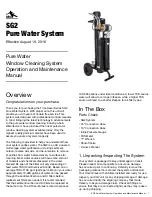
1-800-888-1436
Operating Instructions
5
Connecting your Old Faithful Pumper to the water main
Read all
1.
warnings
displayed on the Old Faithful
Pumper before operation!
WARNING!
2.
Do not run your Old Faithful Pumper
in temperatures below 45° F.
WARNING!
3.
Inspect the supplied high pressure
hose for nicks, cuts or abrasions. If there are any
signs of wear, discard the hose immediately and
call Hurco to order a replacement parts or hoses.
Connect the supplied high pressure hose to the
4.
pressure outlet on the front of the Old Faithful
Pumper. Insert the safety clip.
Determine where you will be making your
5.
connection to the water main. Follow the American
Water Works Association (AWWA) recommendations
or the recommendations of your project engineer
or municipality.
This connection is critical. Do not leave anything
6.
to chance. You must use high quality parts that are
in new condition and meet or exceed the pressure
maximum pressure- rating of your pump and have
been properly installed. The supplied high pressure
hose has a 1/2 inch male iron pipe thread fitting
on the end. You will need to build your connection
from this fitting. Use a high quality, high pressure,
pipe thread sealer on this fitting.
After you have made this connection to the water
7.
main, secure the hose so it will not “whip” in the
event the connection you have made fails.
Recheck all connections and fittings. Be sure all
8.
safety clips are in place and the high pressure hose
is properly secured to prevent “whipping”.
Typical set-up for hydrostatic testing
WARNING:
Do not use your Old Faithful Pumper in
temperatures below 45° F. Do not use worn or damaged
parts when making connection to water main. Be sure all air
is out of water main prior to testing.
Hydrostatic Testing the Water Main
Now that you have properly made all connections to your
water main and have insured that the water main was
properly filled to eliminate trapped air, you are ready to start
your test. Follow these steps;
Read all
1.
warnings
displayed on the Old Faithfull
Pumper before operation!
WARNING!
2.
Do not pressure test in temperatures
below 45° F.
Make sure your water source is full. (Do not connect
3.
to a high pressure water source unless you are using
the Hurco optional float controlled reservoir.)
Raise the pressure release lever to relieve pressure
4.
on the pump when starting the engine.
Start engine.
5.
Be sure the relief or bleed off valve is in the closed
6.
position.
Lower the pressure release lever into the locked
7.
position on the appropriate number setting, (refer
to your Hypro manual).
Slowly open the high pressure valve on the front of
8.
the Old Faithfull Pumper and allow the pressure to
build to the test pressure.
Once the desired pressure is achieved, slowly close
9.
the high pressure valve. This will isolate the pressure
in the water main.
Raise the pressure release lever and turn off engine.
10.
Determining Water Loss for Test Results
There are many methods to determine water loss. Using a
water meter would be one method. A simpler method to
measure water loss would be as follows;
Monitor pressure loss for the specified time
1.
recommended by the engineer or municipality.
Note the pressure drop. For example, the test called
2.
for a 180 PSI test and during the test time period,
the pressure dropped to 140 PSI.
Now, with your Old Faithfull Pumper still connected
3.
to the water main, repeat the instructions for
“Hydrostatic Testing the Water Main” on pages 7 and
8 in this manual.
Pump the pressure in the water main back to the
4.
test pressure. In this example, 180 PSI.
Connect a short piece of garden hose to the relief
5.
connection on the Old Faithful Pumper.
Put the hose into a clean barrel or 5 gallon bucket.
6.
Slowly open the relief valve and allow water to
7.
drain into barrel until the pressure reading on the
pressure gauge drops to the low pressure. In this
example that would be 140 PSI.
Measure water in barrel, this is your water loss.
8.


































